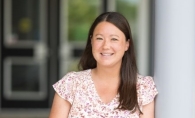Rayme Nyembwe has enjoyed “learning how to collaborate with people who don’t speak my language.” Linnea Brown got a kick out of seeing a Skype view of an open-air, rooftop classroom in Port Au Prince, Haiti. (She thinks having a similar classroom at her school would be “awesome,” but not so much in rain or cold weather.) And Tyler Josephs has enjoyed learning to speak Creole French, along with making friends from a distant culture—distant geographically, not distant in spirit.
Rayme, Linnea and Tyler are among the Otter Lake Elementary third-graders who have used the Skype video app to get to know fellow students, over 3,000 miles away, at the ANA school in Port Au Prince, Haiti. And that’s only the beginning of how students are making global connections in White Bear Lake Area Schools.
Kindergarten students at Birch Lake Elementary School have enjoyed a similar long-distance video project, using Google+ Hangouts—a free video chat service—to bond with fellow kindergartners at a school in Barcelona, Spain. The teacher there is Silvia Sanz, a former student teacher who studied with Birch Lake Elementary teacher Kathleen Elletson two years ago in White Bear. Also, students at a third White Bear Lake elementary school, Matoska International, have been communicating with students and teachers in Africa.
“The goal is to help the kids learn that kids are kids everywhere and that they all like to do the same things,” says Luane Oklobzija, the Otter Lake teacher who arranged the Haitian project, with help from Steve Asper, the district’s technology support manager.
Because much of the recent U.S. mass media information about Haiti has pertained to large-scale disaster-relief aid to the earthquake-torn country, “I wanted to make sure my third-graders understand we can learn as much, if not more, from them, as they can from us,” Oklobzija says.
Through this project, “I think we have learned we have lot in common. My kids have had the opportunity to see kids who are really working at learning in a different kind of environment. They’ve learned how we’re alike and how we’re different,” Oklobzija adds. At one point, the two groups of students collaborated on a joint art lesson making a Haitian art project with tin foil, pencils and markers.
The connection with the Haitian school came through Asper’s volunteer work with a St. Paul-based nonprofit called Kozefo, which donated funds to provide the school with a new computer lab as well as a technology teacher.
At the White Bear schools, the global communication projects “developed organically” through individual connections and teacher initiative, according to Asper. The key was “fostering the idea that we have the technology available right there for students and teachers.” While the international communications projects “come from individual teachers, they are also something we encourage.” The district has 1.5 FTE instructional specialists who help teachers with “anything related to best practices in teaching—how do we incorporate technology, not just for technology’s sake but for really enhancing learning for students. Part of our mission is to have globally informed students going out into the world,” Asper says.
Elletson agrees that the long-distance dialogues are a valuable learning experience that should be made available to more groups of White Bear students in the coming years. The experience “does so much for students; it makes their world seem a lot bigger,” says Elletson. “And having those international connections helps them learn there is so much more to give, to see, do and experience in the world.”









